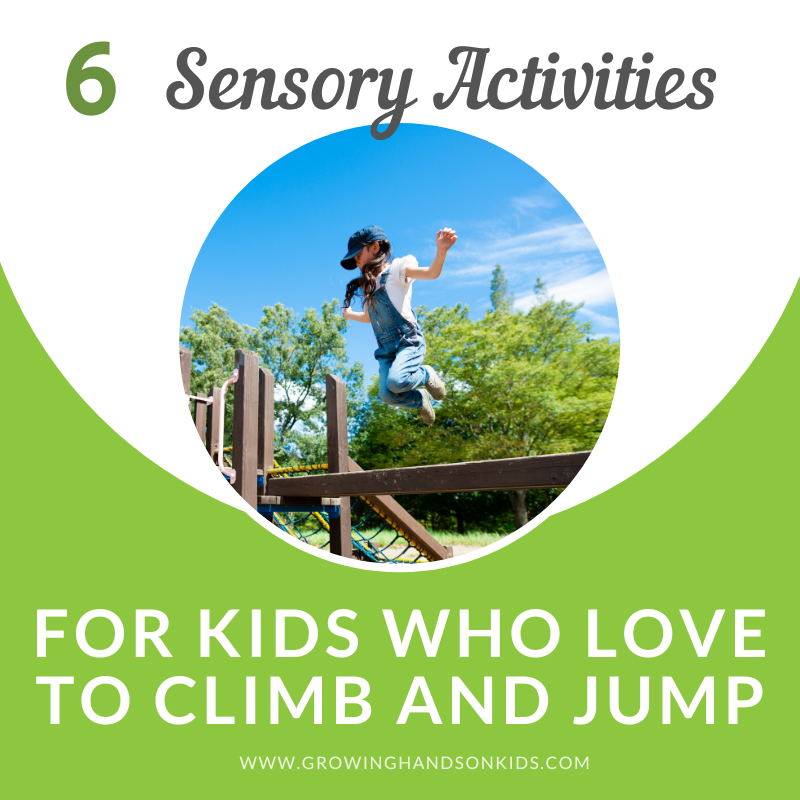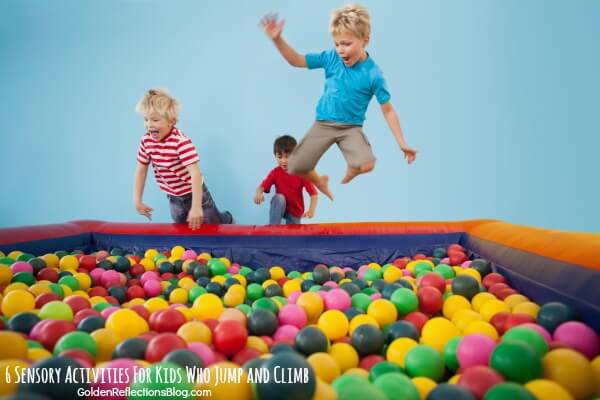6 Sensory Activities for Kids Who Climb and Jump
Affiliate and Referral links are used below to promote products I love and recommend. I receive a commission on any purchases made through these links. Please see my disclosure policy for more details. As an Amazon Associate, I earn from qualifying purchases.
Kids, by nature, are movers. They learn by moving through their environment with their 8 senses. When kids are jumping and climbing they are also using the 6th and 7th senses of the vestibular and proprioceptive systems.
Yes, you really do have a 6th sense. Today we are going to be looking at some simple ways to include sensory activities for kids who love to climb and jump.
My daughter is two years old, so we are right at that stage where jumping and climbing are about all she does. My husband asked me the other day “Does she EVER sit still?” My answer was, “Nope!' But that is how it should be. At two years old, she is learning about the world around her through movement.
She is learning that when she tries to swing on the back of a chair that it most likely will fall back on her (not that we have any experience with this at all). She is realizing how much strength she has in her legs for jumping and that she can actually get both feet off the ground.
My daughter has always loved movement. From the time she was very little, she loved flying through the air with daddy and grandpa. She never shied away from any type of movement. She has never shown any fear of anything.
What is a Sensory Seeker?
I have always described Ellie as a vestibular and proprioceptive sensory seeker. So what do I mean by that?
A sensory seeker is a child who looks for, craves, or seeks certain sensory input. Sensory input can come through touch, sight, hearing, taste, smell, or movement (vestibular input and proprioception).
A sensory avoider is a child who has a fear of, avoids, or does not enjoy certain sensory inputs.
For a quick reference, vestibular input has to do with balance and movement of the inner ear. So movement that involves the head in many different positions is considered vestibular.
Proprioception is sensory input from the large muscle groups (legs and arms) and the spine.
So what does this have to do with jumping or climbing?
Climbers and Jumpers are Craving Proprioceptive and Vestibular Sensory Input!
They are craving that heavy work, deep muscle, and head tilting movement. And climbing and jumping give them the input they crave.
So you have a child who loves to jump and climb on EVERYTHING. At times they may try to jump or climb on things that are not safe. Can we monitor this 24/7? Of course not. Accidents happen.
My daughter, for example, learned quite quickly that if she tried to hang on the back of the dining room chair, it would come back on her. She hasn't tried to hang on to it since. She has moved to hang on the refrigerator door handles or the stove handle. She keeps me on my toes.
You may have a child who will continue this type of behavior because they crave that input so much that safety concerns don't even phase them.
As parents, educators, and family members, we can provide these sensory seekers with the input they need to help decrease the chances of them trying to climb on or jump on unsafe things.
6 Ideas for Sensory Input for Jumpers and Climbers
1. Take your child to play on a playground.
This one may seem like a no-brainer. But getting your child outside for a movement or brain break is going to help them get the sensory input they need. Climbing on the playground equipment, swinging, and jumping over, under, or around playground objects will help them fill that need for vestibular or proprioceptive input.
2. Gymnastics or Tumbling Lessons (if possible)
I realize that not all families are able to do this because of money or distance. But if you are able to I highly suggest doing gymnastics or tumbling lessons. I plan on taking my daughter to tumbling classes this winter when it will be hard to get outside for climbing and jumping. Not only will it provide the needed proprioceptive and vestibular input, but it is also great for core strengthening, balance control, and many other gross motor skills.
3. Make an indoor crash pad
Get some gym floor mats (the thick ones), bean bags, blankets, etc. Make a huge pile and make sure it is safe enough for a child to jump into and not get hurt. Then have a flat surface for them to climb onto (couch, chair, etc) and have them jump into the pile of fluff! I guarantee they will have hours of fun doing this. And of course, please do not do this activity if you cannot be around the monitor.
Here is a great suggestion for a DIY crash mat from the Kids Activities Blog.
4. Get a Mini Trampoline
My husband got this Mini Trampoline recently for my daughter with some birthday money. She L.O.V.E.S it. Plus it is saving my couches, so mommy loves it too! 🙂
5. Doorway pull-up bar
It may seem like this one doesn't fit with jumping or climbing, but it does. Pull-up bars will provide that heavy work and deep muscle movement your child craves. Of course, these are best for older children, not toddlers or younger children.
6. Make an indoor jungle Jim obstacle course
Make your DIY Crash mat from above, have pillows, beanbag chairs, wooden chairs, tunnels, or any other type of object that allows your child to climb on or through and jump on. Make an obstacle course in your house or outside. Have a race to see who can get through the fastest etc. Make it fun for the entire family.
Here are a couple of activity suggestions:
You May Also Like:

Heather Greutman, COTA
Heather Greutman is a Certified Occupational Therapy Assistant with experience in school-based OT services for preschool through high school. She uses her background to share child development tips, tools, and strategies for parents, educators, and therapists. She is the author of many ebooks including The Basics of Fine Motor Skills, and Basics of Pre-Writing Skills, and co-author of Sensory Processing Explained: A Handbook for Parents and Educators.





Great information. I would love to connect with you some more. I work with the YMCA in a preschool setting and i need ALL resources to help my kiddos……smiles….
Thank you so much for the ideas!! I have 3 girls. My oldest was a bit of a daredevil, my middle had to know she could do things before doing them and my youngest, now she’s the one who will go head first over the back of the couch and then keep trying to do it over and over again. I’ve set my furniture up as a little running strip that would be safe for her but it just isn’t enough for her anymore so she has been trying to find other things to do. I really like the DIY crash pad ideas and the tunnels. I’ve got some circular mesh laundry baskets that I was about to throw out due to being torn on the bottoms. I’m now going to turn them into tunnels instead 🙂 I’m so happy I googled what to do and found your ideas beforehand! Thank you so much!!
This is awesome resource. My kid likes climbing on the couches and tables. It has now gotten worse since he wants to climb on top of houses
My son is a climber. I once wrote a review about our stove/oven on Amazon and I mentioned that the handle on the bottom drawer was not a great feature for us currently because our son will hold the oven door and step up on the drawer handle. In the comments people mentioned that I was doing a stinky job watching my kid. Perhaps, sometimes :-). However, the ovens that have drawers that are flat with everything, with just a lip to pull do not allow a kid to attempt to stand on the handle of the drawer. It’s an odd thing that one might never consider until you have it and have toddlers around. Short of bolting our kitchen chairs to our concrete floors, there is no way we could entirely child-proof our house from our young resident monkey. He just uses chairs to get everywhere he wants to get. Oddly, he doesn’t seem inclined to climb at the playground. Just at home and on the counters, the couches, the table and beds. I love these ideas!
Hi I’m wondering what age is a red flag for continued behavior or needing to climb everything before knowing if their is a sensory imbalance. If motor skills balance etc are hitting age appropriate. As I have learned children seek sensory input at every stage of development.
Thanks for all your expertise you share for so many
Good article and list. Pull up bar was a surprise to me but I agree. Thanks for the article and list. Basically kids need to just get out and play.
I really appreciate your suggestions here. I have a three year old boy who is definitely a climber. I am looking for ways to keep him satisfied indoors, as the weather gets cold. I am also trying to give suggestions to his daycare since they have him all day. I want them to have tricks and tools to give him the vestibular, preprioceptive, and tactile activities he needs throughout the day. I am also thinking of potential Christmas present ideas to tell the family to get. Thanks so much! I appreciate any feedback you have.
Hi Kim, I have a few posts here with brain break ideas that all focus on vestibular and proprioceptive activities. If you search brain breaks in the search bar on the side they should all come up, lots of great ideas to pass a long to his daycare.
Oh, I so wish we had the room for an indoor jungle gym! For now my daughter will have to be happy using the couch cushions as a crash pad (and she is! lol!)
Great ideas! We have a 9 yr. Old vestibular and proprioceptive sensory-seeker. Love the crash pad idea. Similar to that, and one more possibility if money and space allow, are two items we found at IKEA. We hung their gymnastics rings and “spinny chair” (hanging swinging, cocoon-like) from the ceiling joists in our basement and added an 8 inch foam mattress below to ensure no head injuries. They have been lifesavers for our active boy during long winters in Ontario! Siblings and friends love ’em too.
Great ideas Marya! Thanks for sharing.
Thank you Heather for another amazing blog post. I’ve learned so much from your blog as well as Lemon and Lime. I feel so encouraged and positive gathering all this information instead of heartbroken and full of guilt. You’ve described my son to a T and I feel more hope then despair navigating this sensory adventure we’re on.
This comment made my day! Thank you so much Jeanine. I am so glad you have found encouragement here. That is my goal. 🙂
My daughter is definitely a seeker when it comes to jumping and climbing! I remember when she was a year and a half and I would be feeding her brother and I’d have to get her off the t.v. with one arm while carrying him in the other.
Safe climbing places are definitely important!